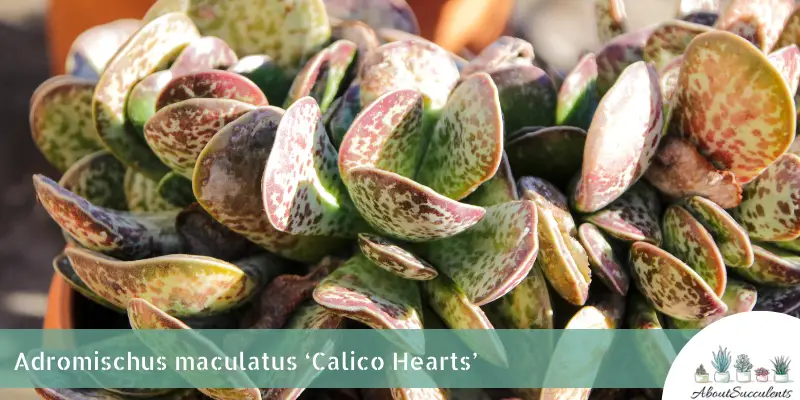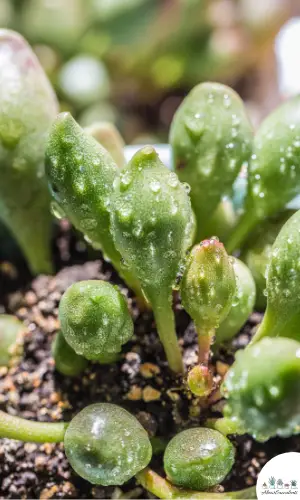
Adromischus Maculatus is an adorable succulent that when grown in a pot might resemble an order of baked purple yam chips inside a serving bowl.
And who can blame you if the sight of this succulent makes you hungry? The leaves of Adromischus are flat, oval-shaped, purple-colored, and accented with white spots.
If saying ‘Adromischus Maculatus’ is a mouthful, you can ask the nursery for either ‘Calico Hearts’ or ‘Chocolate Drop’.
This variety of succulent grows well as an addition to an outdoor garden or as a houseplant to adorn your home. You will get your guests talking about Chocolate Drop when they see this charming succulent grace your living room.
A fully-grown Calico Hearts can reach a height and width of 20cm (8”). This succulent is native to South Africa and is a member of the Crassulaceae family.
General Information
Also known as: Calico Hearts, Chocolate Drop
Plant Family: Crassulaceae
Origin: South Africa
Height: 20cm (8”)
Exposure: Up to 6 hours of partial to full sunlight.
Water Needs: Use the soak and dry method; give the soil a good soaking then wait for it to be completely dry out before watering. This might mean 7 to 10 days between watering schedules.
Soil Type: Well-draining soil such as cactus mix with added gritty materials like coarse sand and perlite.
Soil pH: 6.0
How to Grow and Care for Adromischus Maculatus ( Calico Hearts )

If you decided to grow Adromischus Maculatus in your garden or as a houseplant, then you’ve made an excellent choice because this succulent is easy to care for.
The best time to plant Calico Hearts is during the spring and fall months. This isn’t a cold-hardy succulent and might not survive the frosty weather when planted outdoors.
Plant Chocolate Drop in a ceramic or terracotta pot that can be moved indoors if the temperature in your area falls below -6.7° C or 20° F.
Sunlight
Calico Hearts needs at most 6 hours of morning or late afternoon sunlight every day to stay healthy and to bring out its colors.
You can plant Chocolate Drop in an area of your garden that gets partial or full sunlight. Always avoid the scorching rays of the midday sun as they will scorch your succulent plant’s leaves.
The same lighting rule will apply if Adromischus is grown indoors. Place it near a window that gets 4 to 6 hours of partial sunlight. If the amount of sunlight is an issue, buy Calico Hearts a Grow Light.
Watering

Maintaining the proper watering schedule is perhaps the most important part of growing and caring for Adromischus Maculatus. This is where many first-time succulent hobbyists make a mistake because they water the soil before it has gone completely dry.
Similar to most types of succulents, the soak and dry method works best for Calico Hearts. The soak and dry method means that when watering, you give the soil a thorough drenching.
If Chocolate Drop is grown in a pot, you’ll know that you’ve given the soil enough water when you see the drain holes at the bottom leaking out.
The ‘dry’ aspect of the method means you only water the soil when you can prove it has 100% dried out. Well-draining soil usually will dry out within 7 to 10 days. A big factor would be the season.
Soil retains moisture longer during the winter months and therefore, less watering is required compared to the summer and spring months.
To be sure, insert a stick into the soil. If the stick comes out dry, the soil is ready for soaking.
What happens if you overwater Adromischus? If you give the soil water while it’s still wet, the roots of Calico Heart will rot and could make your plant sick or die.
Don’t worry about missing watering dates for Chocolate Bomb. Like typical succulent plants, it stores water in its leaves and stems. Adromischus Maculatus can survive extended periods without water.
Pot and Soil
As discussed in the previous section, keeping Adromischus Maculatus in a moist environment for a long period of time can be fatal.
Your choice of pot and soil for Calico Hearts must be ones that allow fast drainage of excess water.
Pots made of ceramic and terracotta are ideal for succulents because the materials make it easy for moisture to escape from the soil. The pot must have drain holes at the bottom to enable excess water to leak out.
Place a tray underneath the pot to catch the water that comes out. It’s very important to throw away the excess water to keep the roots from sitting in a moist environment.
Cactus soil mix is a good choice for Adromischus because it drains very well and promotes air circulation. It’s a good idea to add gritty materials such as perlite, pumice, or coarse sand to further improve drainage.
How to Propagate Adromischus Maculatus ( Calico Hearts )
Adromischus Maculatus can be propagated by using its leaves. The important thing to remember is that when you remove the leaf, make sure no part of it is left on the stem.
A clean removal of the leaf from the stem will assure you of a successful propagation of Calico Hearts.
Method 1 – Leaves
Step 1: Perform a clean twist and pull of a healthy leaf from the stem. You can also cut it off with a sterilized knife or garden scissors.
Step 2: Place the leaves in a warm area where they can dry out and develop calluses. This process will take around 2 to 3 days.
Step 3: Once the leaves are covered with hard calluses, you can place them on top of well-draining, fresh cactus soil.
Step 4: Keep an eye out for the roots. Until such time that the roots have sprouted, make sure the soil is frequently moistened with light misting.
Step 5: When the roots have fully sprouted, apply the soak and dry method and water the soil only when it’s dry.
Frequently Asked Questions
Is Adromischus Maculatus ( Calico Hearts ) Toxic to Cats and Dogs?
Adromischus Maculatus is not identified as a toxic plant for cats and dogs on the website of the American Society for the Prevention of Cruelty to Animals (ASPCA).
Keep in mind that the website only has a partial list of plants that are toxic to animals. There are reports that Calico Hearts can make cats and dogs sick.
It would be best to place this succulent plant in a location that can’t be reached by your pet.
Why Is My Adromischus Maculatus ( Calico Hearts ) Dying?
Is your Adromischus Maculatus getting weaker that it might be dying? These types of succulents are durable and resilient to changes in their environment.
Giving Calico Hearts water too frequently and having pests as guests could get it in bad shape.
While they don’t need doting over, you must still look out for these warning signs that mean the succulent is sick or close to death.
Overwatering
Sometimes you can’t help but give Chocolate Drop water because you think the succulent needs it. When it comes to succulent care, you have to be 100% sure the plant needs water before you give it any.
Overwatering is the number 1 killer of succulent plants because it leads to root rot. This happens when the cells burst because the roots have been immersed in moist conditions for a long time.
A fungal infection can find its way into Adromischus Maculatus and cause disease to spread throughout its stems and leaves. Be on the lookout for discoloration and the appearance of black spots.
The leaves of Chocolate Drop could also feel soft and mushy. Remember, succulents already store water in their leaves and stems.
Upon initial observation, don’t waste time. When it comes to root rot, time is of the essence.
Grab a pair of garden shears and sterilize it with 70% isopropyl alcohol. Then cut off all the discolored sections of the plant.
Once this is done, shift your attention to the roots. Remove the plant from the soil and cut off all the roots that have become rotten. Place Calico Hearts in a warm area and let it dry out.
The final step is to re-pot Adromischus. Prepare a ceramic or terracotta pot with fresh cactus mix and replant Calico Hearts in its new home.
Pest Infestation
Pests such as mealybugs and vine weevils share your love for Adromischus Maculatus. They will make your plant their home and help themselves freely of its sap.
You’ll know that Calico Hearts has a case of pest infestation if you notice white, powdery substances appear on its leaves. For sure, mealybugs are hiding in your plant.
Don’t take chances and spray Chocolate Drop with a systemic insecticide or neem oil to keep the pests away. Wipe off the substances with a cotton ball that’s been soaked in 7 0% isopropyl alcohol.
Yes, Adromischus Maculatus produces small, tubular-shaped flowers with white-pink colors during the summer.
Last Updated on June 9, 2022 by Sofia Lara